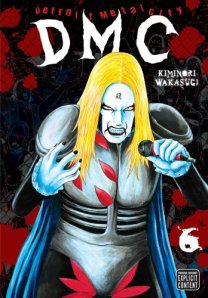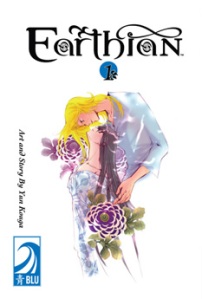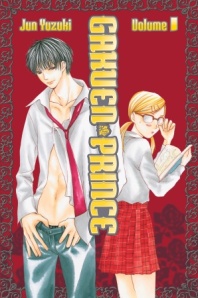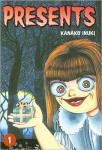No one should be surprised by my Pick of the Week, should they? With that out of the way, I thought I’d take a look at two of the titles on this week’s crowded ComicList. (Okay, they aren’t confirmed on the list, but they’re probably already available through sources other than Diamond.)
 I’ve had a pretty good track record with comics about yokai, diverse supernatural creatures of varying degrees of menace. It’s a fairly popular genre, though, so you’re bound to come across a mediocrity from time to time. This week, the middling yokai are brought by Hiroshi Shiibashi’s Nura: Rise of the Yokai Clan (Viz). It’s about a dull boy whose one-quarter yokai heritage puts him in line to be the big boss of a motley group of minor demons. He’s surrounded by fabulously rendered, energetic creatures who spend too much time in the background in favor of his stereotypical human classmates.
I’ve had a pretty good track record with comics about yokai, diverse supernatural creatures of varying degrees of menace. It’s a fairly popular genre, though, so you’re bound to come across a mediocrity from time to time. This week, the middling yokai are brought by Hiroshi Shiibashi’s Nura: Rise of the Yokai Clan (Viz). It’s about a dull boy whose one-quarter yokai heritage puts him in line to be the big boss of a motley group of minor demons. He’s surrounded by fabulously rendered, energetic creatures who spend too much time in the background in favor of his stereotypical human classmates.
Rikuo wants to emphasize his human heritage rather than his yokai legacy. He objects to the anti-human meanness of his prospective subjects, and he struggles to conceal his weird home life when he’s at school. Dangerous circumstances occasionally draw the yokai part of Rikuo to the forefront, and he becomes an assertive butt-kicker who bears at least a passing resemblance to InuYasha. This only serves to remind you that there’s better folklore-based manga out there for your perusal.
Even with a sprawling cast of frequently charming monsters at his disposal, Shiibashi can’t seem to devote much attention to them. He’s more interested in Rikuo’s secret-identity shenanigans, his generically flinty female friend, and the idiot rival who develops a boy-crush on Rikuo’s forceful alter ego. They’re a predictable group, as are their escapades. I’d much rather see what was happening at Rikuo’s yokai-packed family manse than follow this shônen-ready Marilyn Munster around.
 On a happier, though still decidedly gothic note, I like the second volume of Kaori Yuki’s Grand Guignol Orcheastra (Viz) better than I did the first. It inches closer to becoming a Yuki title that I can fully embrace, balancing melodrama, a dizzying aesthetic, and weird spikes of both humor and gore.
On a happier, though still decidedly gothic note, I like the second volume of Kaori Yuki’s Grand Guignol Orcheastra (Viz) better than I did the first. It inches closer to becoming a Yuki title that I can fully embrace, balancing melodrama, a dizzying aesthetic, and weird spikes of both humor and gore.
For those who have forgotten, it’s about a traveling group of magicians who battle the zombies that have overrun their sort-of period, kind-of European country. Their leader and vocalist, a guy named Lucille, has dark secrets and likes to dress in drag. Their pianist, a girl named Eles, has a tragic past and disguises herself as a boy. Their companions are seedy, and the government line on their efforts is ambivalent on the best days.
In the second volume, Yuki seems to find both a more assured narrative rhythm and more underlying heft to her story. The back story she reveals about Lucille adds necessary layers to the character without undermining his essential ridiculousness. It also provides a strong, underlying subplot to fuel future stories.
Yuki’s penchant for the absurd and just slightly perverse is still on unapologetic display. Our protagonists go undercover in a convent, looking for a sacred relic and investigating the grisly murders of young nuns. This mini-arc is shaping up to be both creepy and very funny, provided you find secretive nuns committing and subjected to unexpected violence funny, which, I assure you, I do.
Grand Guignol Orchestra is still a bit on the bubble for me, but it’s sliding off of it and onto firmer ground. It’s not a singular kind of story, but Yuki’s work is as coherent as I’ve seen it while still displaying the quirkiness that’s made her a sort of superstar.
(Comments are based on review copies provided by the publisher. Nura is currently running in Shueisha’s Weekly Shônen Jump, and it’s up to about 14 volumes, so maybe it gets better. Grand Guignol Orchestra ran for five volumes in Hakusensha’s Bessatsu Hana to Yume.)
As for books that will be available through Diamond, the highlight has to be the 13th volume of Osamu Tezuka’s medical melodrama, Black Jack (Vertical). In the perfectly understandable excitement over Vertical’s announcement of the licensing of Tezuka’s Princess Knight, we shouldn’t forget this often gruesome, frequently moving, creepily funny classic.
Another excellent arrival is the 22nd volume of Hikaru no Go (Viz), written by Yumi Hotta and illustrated by Takeshi (Death Note, Bakuman) Obata. This marvelous series about a young man who dreams of becoming a great Go player ends with volume 23, I think, but it’s worth starting from the beginning if you haven’t yet done so.
I haven’t read the first volume yet, but various enthusiastic reviews have persuaded me that I need to catch up with Yuuki Fujimoto’s The Stellar Six of Gingacho (Tokyopop), second volume due Wednesday, about a group of kids, all children of local shopkeepers, who try and reestablish their waning friendship. In my defense, Tokyopop’s marketing is often confusing to me, and I’m never sure if I’m going to get The Secret Notes of Lady Kanoko or KimiKiss.





























Upcoming 2/9/2011
It’s a huge week for Viz via Diamond, though some books have already shipped through other venues. (See my pick of last week and my pick of this week, and bask in the bafflement!) If you buy your manga shopping via Diamond-dependent comic shops, you have many, many choices, at least according to the ComicList.
This was a concern, since the first two volumes form what must be an adaptation of Yukino’s first novel in the series. Having established the leads, seemingly feckless emperor Ryuki and his frugal, forceful tutor, Shurei, Yura and Yukino put them in danger in the form of palace intrigue. To be entirely honest, the details of the scheme are much less interesting than Ryuki and Shurei’s individual and collective responses to it. But their shifting but well-balanced relationship is still a complete treat, and the prospect of reading about their next encounter is pure, happy anticipation.
If you like stories about smart, feisty girls sparring with deeper-than-they-seem boys, this series can be injected directly into a vein for that sweet, sweet rush of shôjo romance between the very different but equally matched.
In other Viz news, there’s the seventh volume of the always welcome Kimi ni Todoke: From Me to You, written and illustrated by Karuho Shiina. This one promises lots of holiday activity, which is always fun.
There’s also the less welcome but still potentially intriguing second volume of Genkaku Picasso, written and illustrated by Usumaru Furuya. I wasn’t especially impressed with the first volume, but I find Furuya kind of fascinating, so I’ll probably succumb at some point.
What looks good to you?